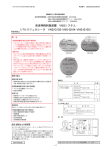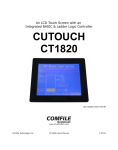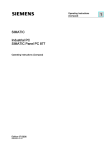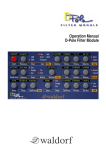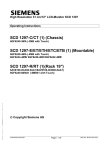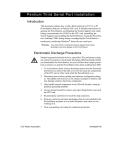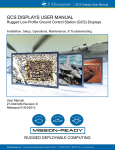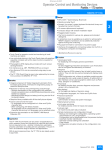Download SIMATIC HMI SCD1900, 19” Touch Operating - Internet
Transcript
Bedienhandbuch SIMATIC HMI SCD1900, 19” Touch Operating Instructions SCD1900 6AV7862-2TA00-1AA0 (Landscape) 6AV7466-2TA17-0AA0 (Portrait) © Copyright Siemens AG SIMATIC HMI SCD1900 Seite 1 / 29 DOC-No.: SCD1900 MANUAL.DOC Bedienhandbuch No part of this document may be reproduced or transmitted without express permission. Violations will result in prosecution. All rights reserved. 2011 All rights reserved SIMATIC HMI SCD1900 Seite 2 / 29 DOC-No.: SCD1900 MANUAL.DOC Bedienhandbuch Contents 1 1.1 1.2 1.3 Overview ................................................................................................................5 Layout of this Handbook .........................................................................................6 Warnings and Safety Notes.....................................................................................7 Instructions for Handling Components Susceptible to Electrostatic discharge ........8 2 2.1 2.2 2.3 2.4 2.4.1 2.4.2 2.4.3 2.4.4 2.4.4.1 2.4.4.2 2.5 2.6 2.6.1 2.6.2 General Installation ...............................................................................................9 Removing the Packaging and Checking Individual Parts ........................................9 Scope of Delivery ....................................................................................................9 Installing the LCD-Device ........................................................................................9 Cable Connections and Pin Assignments .............................................................13 DVI Interface .........................................................................................................14 VGA-Interface .......................................................................................................15 Touch Interface - USB ...........................................................................................15 Power supply.........................................................................................................16 24V DC power supply ..............................................................................................16 230 V AC power supply (optional) ...........................................................................16 Electrical Installation .............................................................................................16 Touch Functionality ...............................................................................................17 Installation of touch driver software UPDD ............................................................17 Calibration the touch screen..................................................................................17 3 3.1 3.2 3.2.1 3.2.2 3.2.2.1 3.2.2.2 Operation and Alignment ...................................................................................18 Location of the Operation and Alignment Controls ................................................18 Using and adjusting the device .............................................................................19 Quick-OSD-Menu ..................................................................................................19 OSD-Menu ............................................................................................................21 Structure of the On Screen Display Menu (DVI)....................................................22 OSD-Menu-Function (VGA) ..................................................................................24 4 4.1 4.2 4.3 4.4 4.5 4.6 4.6.1 4.6.2 4.7 4.7.1 4.7.2 4.8 Technical Data .....................................................................................................25 Display Module......................................................................................................25 Power Supply ........................................................................................................25 Operating Conditions ............................................................................................25 Protection ..............................................................................................................25 Enclosure ..............................................................................................................26 Mechanical requirements ......................................................................................26 Operation ..............................................................................................................26 Packed unit ...........................................................................................................26 Input Signal ...........................................................................................................26 Digital Signal .........................................................................................................26 Analog Signal ........................................................................................................26 EU Declaration of Conformity on EMC ..................................................................27 5 5.1 5.2 5.3 5.4 5.5 Remarks and contact addresses .......................................................................28 Remarks ................................................................................................................28 Additional support .................................................................................................28 Trainings Center....................................................................................................29 Technical Support .................................................................................................29 Service & Support on the Internet .........................................................................29 SIMATIC HMI SCD1900 Seite 3 / 29 DOC-No.: SCD1900 MANUAL.DOC Bedienhandbuch Figures Fig. 1: Mounting of SCD1900.............................................................................................10 Fig. 2: Clamp for mounting.................................................................................................10 Fig. 3: Dimensions of the SCD1900 (landscape) ...............................................................11 Fig. 4: Dimensions of the SCD1900 (portrait) ....................................................................12 Fig. 5: Location of the operation and alignment controls ...................................................18 SIMATIC HMI SCD1900 Seite 4 / 29 DOC-No.: SCD1900 MANUAL.DOC Bedienhandbuch 1 Overview The LCD device SCD1900 has been developed and constructed especially for industrial applications. This device can be used in industrial systems with particular demands, e.g. immune to electromagnetic radiation. Its compact enclosure opens up a wide spectrum of possible application areas for the SCD1900. The monitor is available for two orientations portrait and landscape. With the use of the trend-setting LCD technology in this device relegated picture geometry distortion and color patches are no longer an issue. Even at the low refresh rate of 50 Hz the screen remains flicker-free. The SCD1900 thus fulfils even the strictest ergonomic requirements. Pictures of lower resolution are expanded to fill the screen. The monitor is available in landscape version and portrait version. The SCD1900 can display up to 16.7 Mio. colors. This allows showing true color images and videos. The LCD-device contains special hardware to convert a standard analogue VGA and digital DVI video signal. Compatibility with conventional CRT devices is guaranteed. The adjustment of the device will be done via the clearly designed OSD (On Screen Display). Tedious adjustments are a thing of the past with the “Automatic Alignment” function. At the press of a button, the monitor performs these alignments automatically. The SCD1900 is equipped with an active 19” TFT display module with a maximum resolution of 1440 x 900 pixels. The integrated power management system VESA DPMS, allows a significant reduction in power consumption when the synchronization signal from the computer has been switched off, compared with that under “normal” operation. SIMATIC HMI SCD1900 Seite 5 / 29 DOC-No.: SCD1900 MANUAL.DOC Bedienhandbuch 1.1 Layout of this Handbook This handbook should be kept within reach while installing and operating the LCD-device. It has been laid out so that even inexperienced users can find the information they require. Chapters are clearly arranged according to subject. In detail, the chapters are arranged as follows: Chapter 1 Introduction This chapter provides a brief description of the SCD1900, including its properties, application areas and special features. Chapter 2 Installation This chapter is mainly concerned with preparing the LCD-device for use, its installation and cabling. Chapter 3 Operation All operations and adjustment possibilities for the SCD1900 are described here. Chapter 4 Technical Data This chapter contains technical details such as dimensions, power supply, environmental considerations and EMC data. Chapter 5 Remarks The chapter gives you additional information and contact information. Important: The manufacturer has gone to great lengths to match the quality of the documentation to the high standard of this product. In achieving this, we are reliant on the support of our customers. SIMATIC HMI SCD1900 Seite 6 / 29 DOC-No.: SCD1900 MANUAL.DOC Bedienhandbuch 1.2 Warnings and Safety Notes Transport The LCD-device should only be transported in its original packaging to ensure it will be protected against shocks and rough handling. Setting up When installing the device, it should be noted whether any moisture (condensation) has entered the unit during transport or storage. Additional important installation information can be found in the “Technical Data” chapter. EMC This LCD-device is a component designed for building into industrial systems. The operator of the entire plant is responsible for maintaining electromagnetic compatibility according to EMC-law. Repairs Before the unit is opened, the supply voltage must be switched off. Only authorized persons may open the unit. Additions or changes to the unit may damage the system or affect its EMC behavior. Cleaning The unit must be isolated from the power supply before cleaning. If heavily soiled, the LCDdevice can be cleaned with a damp cloth and mild detergent. Care must be taken to ensure that no moisture enters the unit during cleaning. Scouring powders and solvents must never be allowed to come in contact with the unit. The inside of the unit is to be cleaned by qualified service technicians only. SIMATIC HMI SCD1900 Seite 7 / 29 DOC-No.: SCD1900 MANUAL.DOC Bedienhandbuch 1.3 Instructions for Handling Components Susceptible to Electrostatic discharge Most of the assemblies within the SCD1900 contain components which can be destroyed by electrostatic voltages. It is also possible for the assemblies to be damaged in such a way that total failure does not occur. If you (as an authorized service technician) are handling such assemblies then the following precautions should be observed: • When such assemblies are being handled, a means of electrostatic discharge must be available. This can be, for example, a grounded object, which can be touched to discharge electrostatic voltages. • This applies to all insulated used tools. They must also be discharged at grounded object. • When assemblies are removed or added to the system, the unit must always be switched off and the power supply cable disconnected. • Vulnerable assemblies should always be held by their edge. Avoid touching tracks and contact pins. SIMATIC HMI SCD1900 Seite 8 / 29 DOC-No.: SCD1900 MANUAL.DOC Bedienhandbuch 2 General Installation Preparation for installing the LCD-device includes the following points: • Removal of all packaging • Checking of components for damage • Comparison of components received with those on the delivery note • Connection to the computer system and power supply • Building into your system, bearing in mind technical and ergonomic aspects 2.1 Removing the Packaging and Checking Individual Parts After unpacking all the delivered components, they should be checked for completeness and for possible transport damage (visual inspection). If any deficiencies are found then please contact the service department given on the delivery note. Have the delivery note number, serial number and a description of the deficiency to hand. The original packaging should be kept for future transportation. 2.2 Scope of Delivery • Cable set 1,8 m – VGA, USB und DVI • 10 bracket • Documentation • Driver-CD 2.3 Installing the LCD-Device The SCD1900 will be placed in panel cut out and mounted with 10 clamps (see Fig. 1 and Fig. 2) at the cut out frame in the rear, 3 clamps each top/bottom and 2 clamps each left/right. To fix the device the clamps will be hang in the provided holes at the bezel and the screws tighten (max 50 Ncm) (see Fig. 1 and Fig. 2). The panel cut out is prepared according to the drawing (see Fig. 5) The SCD1900 must be close-fitting to the panel to keep the protective. If the surface structure is coarsely to leaks must be tested. Attention: All 10 clumps must be used and both hooks must be hanged up. The monitor is available for two orientations portrait and landscape. SIMATIC HMI SCD1900 Seite 9 / 29 DOC-No.: SCD1900 MANUAL.DOC Bedienhandbuch Vertical installation and deviations between +20° and –20” is permitted. Fig. 1: Mounting of SCD1900 Fig. 2: Clamp for mounting SIMATIC HMI SCD1900 Seite 10 / 29 DOC-No.: SCD1900 MANUAL.DOC Bedienhandbuch Fig. 3: Dimensions of the SCD1900 (landscape) SIMATIC HMI SCD1900 Seite 11 / 29 DOC-No.: SCD1900 MANUAL.DOC Bedienhandbuch Fig. 4: Dimensions of the SCD1900 (portrait) SIMATIC HMI SCD1900 Seite 12 / 29 DOC-No.: SCD1900 MANUAL.DOC Bedienhandbuch Thermal In order that the LCD-device maintains an optimum operating temperature while in use, air must be allowed to circulate freely around the SCD1900 enclosure. It is particularly important that the rear of the system is kept free. Please bear in mind that increased temperatures can lead to defects and to a significant reduction in the lifetime of the device. EMC This LCD-device is a piece of equipment designed for building into an industrial system. The operator of the entire plant is responsible for maintaining electromagnetic compatibility according to EMC laws. Safety All voltage and signal connections must adhere to appropriate legal requirements. Ergonomics The screen should be easily viewable from all sides and without reflections. Harmful gas Supply air with harmful gas is not allowed because of limitation in harmful gas resistance, 2.4 Cable Connections and Pin Assignments The LCD-device has been tested and set-up in the factory. Before use, the power supply and the signals should be connected to the sockets provided. Connections to the device should adhere to EMC regulations. The added DVI cable should be used for the signal connection to the PC (alternative can be used the VGA cable). For the use of the Touch screen connect the SCD1900 with PC via the USB cable. SIMATIC HMI SCD1900 Seite 13 / 29 DOC-No.: SCD1900 MANUAL.DOC Bedienhandbuch 2.4.1 DVI Interface The DVI interface is a 29-pin DVI-connector. Pin Signal 1 TMDS-Data 2 - 2 TMDS-Data 2 + 3 TMDS-Data Shield 2 (GND) 4 - 5 - 6 DDC-CLK 7 DDC-DATA 8 Analogue V-Sync. 9 TMDS-Data 1 - 10 TMDS-Data 1 + 11 TMDS-Data Shield 1 (GND) 12 - 13 - 14 +5 V Power (In) 15 GND 16 Hot Plug Detect 17 TMDS-Data 0 - 18 TMDS-Data 0 + 19 TMDS-Data Shield 0 (GND) 20 - 21 - 22 TMDS-CLK Shield (GND) 23 TMDS-CLK + 24 TMDS-CLK - SIMATIC HMI SCD1900 Seite 14 / 29 DOC-No.: SCD1900 MANUAL.DOC Bedienhandbuch 2.4.2 VGA-Interface The VGA interface is a standard 15-pin male HD-D-type connector. Pin Signal 1 Video input RED 2 Video input GREEN 5 3 Video input BLUE 15 14 4 Not used 5 Not used 6 GND (RED) 7 GND (GREEN) 8 GND (BLUE) 9 Not used 10 GND 11 Not used 12 Not used 13 H-Sync. 14 V-Sync. 15 Not used 2.4.3 4 10 3 9 13 2 8 12 1 7 11 6 Touch Interface - USB Pin Signal 1 2 +5V Data - 3 Data + 4 GND SIMATIC HMI SCD1900 Seite 15 / 29 DOC-No.: SCD1900 MANUAL.DOC Bedienhandbuch 2.4.4 Power supply As the Power supply will be used a 24 V DC power connector or optional the external 230 V AC power supply on the rear of the unit. 2.4.4.1 24V DC power supply Type: Phoenix - MSTB-03G Pin Signal Description 1 GND Ground / Minus 2 GND Ground / Minus 3 +24V Power supply +24V DC 2.4.4.2 230 V AC power supply (optional) The AC/DC power supply unit (24 V DC ) is fixed by a bracket on the rear of the unit. The connector of the DC-24V supply line will be plugged into the DC interface of the SCD1900. The cables will be fixed depending from the version with cable clips or binder to avoid unintended disconnection of the plug from the device. 2.5 Electrical Installation Before connecting the SCD1900 to the power supply, it should be checked if the signalconnector is plugged in properly and that the screws are tightened. There are many possible reasons why an image might fail to appear on the display after it has been switched on: • no signal connected • no synchronization signal connected • horizontal and vertical synchronization signals are connected the wrong way round SIMATIC HMI SCD1900 Seite 16 / 29 DOC-No.: SCD1900 MANUAL.DOC Bedienhandbuch 2.6 Touch Functionality The documentation and software for starting up of Touch are included on the CD which is part of the delivery. The following Software tools are part of the CD: • UPDD (Touch driver and calibration) • TouchInput (Virtual Keyboard) • OnSreenKeyboard (OSK-Gina, Possibility for enter into Windows-login-screen via Touch) 2.6.1 Installation of touch driver software UPDD For installation of the touch driver software follow the instruction in user manual (UPDD_en.pdf) on CD. 2.6.2 Calibration the touch screen The calibration is described in the file UPDD.doc on the CD. SIMATIC HMI SCD1900 Seite 17 / 29 DOC-No.: SCD1900 MANUAL.DOC Bedienhandbuch 3 Operation and Alignment This chapter contains a description of all the operating and alignment functions. 3.1 Location of the Operation and Alignment Controls All the controls are accessible from the rear of the unit. Following Fig. 5 shows the position. These controls are used for navigating, for selecting and altering parameters in the OSD menu. Fig. 5: Location of the operation and alignment controls The functions of the keys are described in chapter 3.2.1 and 3.2.2. SIMATIC HMI SCD1900 Seite 18 / 29 DOC-No.: SCD1900 MANUAL.DOC Bedienhandbuch 3.2 Using and adjusting the device Since there are no standards for video output signals from graphic cards, the first time the unit is switched on in DVI use it will automatically adjust itself to the pixel resolution card currently being used. Via the analog VGA interface an automatically identification of the resolution thru the PC is not possible the adjustment must be done manually via the operation system. (Start>adjustment->system control->display) Some standard graphic controllers with included driver do not support the resolution. In that case a similar resolution should be selected. The picture will be adjusted to the resolution of the monitor by its internal electronic. Because of the interpolation the picture is slightly diffuse. Basically the digital DVI interface is recommended. OSD-Menu / Quick-OSD-Menu The „On Screen Display“ OSD is a menu system, which is shown on the display. With the help of OSD and the described controls elements (4 keys in the rear), all adjustments of the device are executable. In addition to the OSD menu there are more possibilities to adjust important functions like brightness, contrast and automatic adjustment directly via a Quick-OSD-menu. 3.2.1 Quick-OSD-Menu Function(s) of the control keys: Key Function + • • • • - • Decrease the parameter value MEN • No function in the Quick-OSD SET • Start Quick-OSD-Menu • Adjust the contrast / brightness • Choose of Quick OSD function Start Quick-OSD-Menu Increase the parameter value Selection of the input signal: Automatically alignment of the pictures SIMATIC HMI SCD1900 Seite 19 / 29 DOC-No.: SCD1900 MANUAL.DOC Bedienhandbuch Following adjustments can be done via the Quick-OSD-menu: Invoke via key <SET> Function Adjustment/value Description Range: 0 to 100 via key <+>/<-> Contrast adjustment Range: 0 to 100 via key <+>/<-> Brightness adjustment Function Adjustment/value Description Source digital DVI, RGB Press <SET> to choose; Press <+> to select Selection of input-source Press key <+> to start the adjustment Perform an automatic image adjustment. Adjustment of frequency, phase and image position. Invoke via key <+> SIMATIC HMI SCD1900 Seite 20 / 29 DOC-No.: SCD1900 MANUAL.DOC Bedienhandbuch 3.2.2 OSD-Menu Function(s) of the control keys: Key Function + • Increase the parameter value • Go to the right - • Decrease the parameter value, • Go to the left MEN • Start OSD • Select the main menu/submenu SET • Scroll down or select menu idem in main menu / submenu Invoke via key <MEN> The OSD varies depending form the represented signal-source. OSD functionality by represented RGB (VGA)-signal and DVI signal are described in the following captures. SIMATIC HMI SCD1900 Seite 21 / 29 DOC-No.: SCD1900 MANUAL.DOC Bedienhandbuch 3.2.2.1 Structure of the On Screen Display Menu (DVI) Main menu Function Adjust function / value / range Description Picture 1 Brightness setting range: 0 to 100 through key (+/-) adjust brightness Contrast setting range: 0 to 100 through key (+/-) adjust contrast change contrast between dark and light colors scaling fill all; fill aspect ratio scaling of the picture Sharpness 1, 2, 3, 4, 5 adjust sharpness of the picture by using no. 1 to 5 1=sharp, 5= soft Gamma Linear or CRT correction of gamma curve value of colors will be forwarded to the display Color temperature 5000 - 7300 – 9300 - VAR color temperature / adjust color three defined and one adjustable color temperatures are for selection Activate „VAR“ - for RGB shows up an adjustment beam. 0 to 100 % (50% correspond to factor 1) OSD select between nine defined OSD positions define position OSD OSD H-Position setting range : 0 to 100 through key (+/-) move OSD-menu in horizontal position OSD V-Position setting range : 0 to 100 through key (+/-) move OSD-menu in vertical position OSD timeout 5 ... 60 seconds adjust time after the OSD menu is automatically fade out the adjustment ensures between 5 to 60 s in steps of 5 s. OSD background Opaque – Transparent Select background color of the OSD menu you have the choice between transparent and colored background. Backlight setting range : 0 to 100 through key (+/-) Adjust brightness of backlight herewith you can match the brightness of the picture with the brightness of the room. DPMS ON – OFF Display Power Management System (DPMS) on or off If DMPS activated, the device is turn off (backlight) when a synch signal is left. The screen is dark. Source scan OFF – ON Standard: ON Note: To scan new video source is not relevant because the device has one RGB input source only. Blank color red – green – blue – black Choose the background color of the screen when no input signal is present. Info signal source ON – OFF Input source icon on or off The icon is shown when input signal are changed. The icon shows the following information’s: signal source (e.g. RGB analog) Mode number (internal mode number of the timing list) Image resolution of the input signal H- and V-frequency Picture 2 Option 1 Option 2 SIMATIC HMI SCD1900 Seite 22 / 29 DOC-No.: SCD1900 MANUAL.DOC Bedienhandbuch Main menu Function Adjust function / value / range Description Option 3 Noise suppression ON - OFF Standard setting OFF. At ON: Activation of function for noise suppression in synchronization signals. Inhibits new auto-alignment during display of a video signal when short-term noise is present on synchronous signals. Lock RGB Signal 1 ON Standard setting OFF. At ON: The video timing currently shown will be stored, and processed with higher tolerance in H- and V-frequency. I.e. the settings of this timing will always be used, even if variations in H- and V-frequency will occur by noise. Prevents erroneous recognition of timing when recognizing a noisy video signal, e.g. showing up as wrong centering or resolution of picture. Unlock RGB Signal 1 OFF <+ Key> Standard setting OFF. (Video timing 1 released again). Lock RGB Signal 2 ON Standard setting OFF. At ON: The video timing currently shown will be stored, and processed with higher tolerance in H- and V-frequency. I.e. the settings of this timing will always be used, even if variations in H- and V-frequency will occur by noise. Prevents erroneous recognition of timing when recognizing a noisy video signal, e.g. showing up as wrong centering or resolution of picture. Unlock RGB Signal 2 OFF <+ Key> Standard setting OFF. (Video timing 2 released again). Language English – German OSD language Factory reset <+> press Reset of values like brightness, contrast,.. to default values Installation RGBMode <+> press Enter a new timing which is not in the internal timing table. This function should used, when the shown image resolution is not the resolution are expect. When press <+> the sub menu expect 9 timing parameter. Utilities <+ Key> <+ Key> When <+>, Info H- and V-Frequency – Show the H- and V-Frequency of the present input signal. H/V-total, H/V-start – Show the used timing parameter of the present input signal Option Var. RGB-Mode inactive, Mode1, Mode2, Mode3 Inactive: used the internal timing table only Mode1: use the timing parameter and perform a complete auto adjustment. (usually used) Mode2: use the timing parameter and perform an auto adjustment without an automatic image position adjustment. Mode3: use the timing parameter and perform an auto adjustment without an automatic frequency adjustment. H-resolution 100 to 2000 through key (+/-) Horizontal image resolution V-resolution 100 to 2000 through key (+/-) Vertical image resolution H-total 100 to 2500 through key (+/-) Whole pixel per line H-Start 0 to 750 through key (+/-) Number of Pixels from H-sync start to image start V-Start 0 to 500 through key (+/-) Number of lines from V-sync start to image start Install <+> press Activate the feed timing parameter test pattern <+> press Show a test image Firmware, Resolution, Timing – Show the firmware version and timing data of the present input signal SIMATIC HMI SCD1900 Seite 23 / 29 DOC-No.: SCD1900 MANUAL.DOC Bedienhandbuch 3.2.2.2 OSD-Menu-Function (VGA) Main menu Function Adjust function / value / range Description Picture 1 Brightness setting range: 0 to 100 through key (+/-) adjust brightness Contrast setting range: 0 to 100 through key (+/-) adjust contrast change contrast between dark and light colors H Position setting range: 0 to 100 through key (+/-) move picture in horizontal direction V Position setting range : 0 to 100 through key (+/-) move picture in vertical direction Phase setting range : 0 to 31 through key (+/-) adjust phase of input signal Frequency setting range : 950 to 1050 (dependent to picture) through key (+/-) adjust frequency of input signal scaling fill all; fill aspect ratio scaling of the picture Picture … See chapter Structure of the On Screen Menu (DVI) page 22 Option 1 See chapter Structure of the On Screen Menu (DVI) page 22 Option 2 See chapter Structure of the On Screen Menu (DVI) page 23 Option 3 See chapter Structure of the On Screen Menu (DVI) page 23 Utilities See chapter Structure of the On Screen Menu (DVI) page 23 Info See chapter Structure of the On Screen Menu (DVI) page 23 SIMATIC HMI SCD1900 Seite 24 / 29 DOC-No.: SCD1900 MANUAL.DOC Bedienhandbuch 4 Technical Data 4.1 Display Module Type active Color TFT-LCD Diagonal 48.1 cm (19.0") Display area (WxH) Resolution landscape 408.2 x 255.2 mm² portrait 255.2 x 408.2 mm² landscape 1440 x 900 pixels portrait 900 x 1440 pixels Pitch 0.2835 x 0.2835 mm² Colors 16.7 Mio. Backlight LED Brightness (typical) approx. 250 cd/m² Contrast 1000:1 Viewing angle (min.) 4.2 L/R 85° (Landscape) 80° (Portrait) O/U 80° (Landscape) 85° (Portrait) Power Supply Input voltage Limited power source max. 8A 18 – 36 V DC Power consumption (typical) < 20 W Power consumption (Standby) approx. 5 W Inrush current 25 A 4.3 Operating Conditions Operating temperature 5 to +40 °C Storage temperature -20 to +60 °C Relative humidity in operation max. 85% by +30 °C 4.4 Protection Protection Class IP65 front Front glass Antireflective glass SIMATIC HMI SCD1900 Seite 25 / 29 DOC-No.: SCD1900 MANUAL.DOC Bedienhandbuch 4.5 Enclosure Weight approx. 5.5 kg Enclosure material aluminum 4.6 Mechanical requirements 4.6.1 Operation Vibration According to EN 60068-2-6 5 ... 8.5 Hz with ± 3.5 mm deflection 8.5 ... 150 Hz at 1g Shock According to EN 60068-2-29 50 m/s², 30 ms 4.6.2 Packed unit Vibration According to EN 60068-2-6 5 ... 8.5 Hz with ± 3.5 mm deflection 8.5 ... 500 Hz at 1g Shock According to EN 60068-2-29 250 m/s², 6 ms (in storage packaging) 4.7 Input Signal 4.7.1 Digital Signal Type Standard signal DVI 1.0 Pixel Frequency 25 – 140 MHz 4.7.2 Analog Signal Level (Video) 0.7 V SS RGB analogue at 75 Ω Bandwidth 300 MHz (-3dB) Impedance 75 Ω Synchronization - Sep. Sync. (TTL) - Sync on green - Composite Sync H-Frequency 30 to 97 kHz V-Frequency 50 to 72 Hz SIMATIC HMI SCD1900 Seite 26 / 29 DOC-No.: SCD1900 MANUAL.DOC Bedienhandbuch 4.8 EU Declaration of Conformity on EMC SIMATIC HMI SCD1900 Seite 27 / 29 DOC-No.: SCD1900 MANUAL.DOC Bedienhandbuch 5 Remarks and contact addresses 5.1 Remarks Invalidity of guarantee All unauthorized electrical or mechanical alterations on or in the unit result in loss of the guarantee. Information on the Instruction Manual For clarity reasons, this Instruction Manual does not contain all detailed information on this product. Your attention is additionally drawn to the fact that the contents of this Instruction Manual are not part of a previous or existing agreement, commitment or statutory right and do not change the latter. Warranty All commitments on the part of Siemens AG are contained in the respective sales contract which also contains the complete and solely applicable warranty conditions. These warranty conditions in the contract are neither extended nor limited by the contents of this Instruction Manual. Repairs Please contact your distributor from whom you originally purchased the product. Environmental protection When disposing of the device, the requirements and laws in the respective country must be observed. 5.2 Additional support If you have any further questions about the use of products described in this manual and do not find the right answer here, contact your local Siemens representative. A guide to the technical documentation for various products and system is available on the Internet: Internet: www.siemens.com/asis The online catalog and online ordering systems are also available on the Internet: Internet: www.siemens.com/asis SIMATIC HMI SCD1900 Seite 28 / 29 DOC-No.: SCD1900 MANUAL.DOC Bedienhandbuch 5.3 Trainings Center To help you get started with automation technology and systems, we offer you variety of courses. Contact your regional Training Center or the central Training Center in D-90327 Nuremberg, Germany. Phone: + 49 911 895-3200 Internet: www.siemens.com/asis 5.4 Technical Support You can access technical support for al A&D projects via the following: Phone: + 49 (0) 911 895 7222 Fax: + 49 (0) 911 895 7223 Mail: [email protected] Internet: www.siemens.com/asis 5.5 Service & Support on the Internet In addition to our documentation, we offer y comprehensive online knowledge base on the Internet at: • Following information will be found, for example: • Our newsletter containing up-to-date information on your products • The documents you need via our Search function in Service & Support. • A forum for global information exchange by users and specialists • You local Automation & Drives representative • Information about on-site service, repairs and spare parts. Much can be found under “Services” Internet: www.siemens.com/asis SIMATIC HMI SCD1900 Seite 29 / 29 DOC-No.: SCD1900 MANUAL.DOC





























